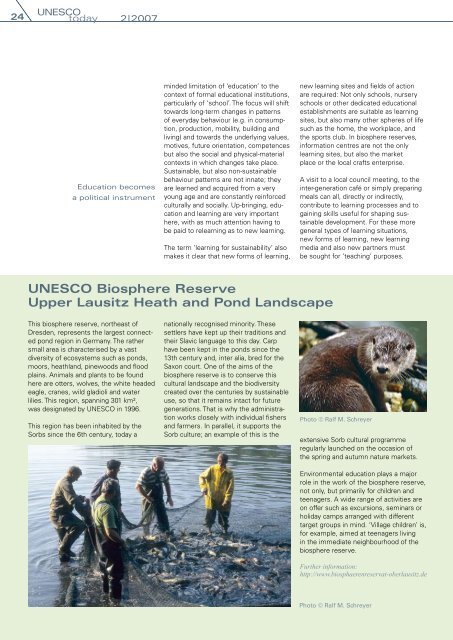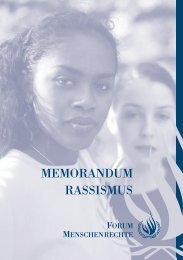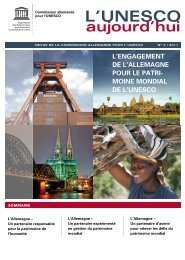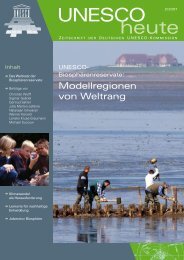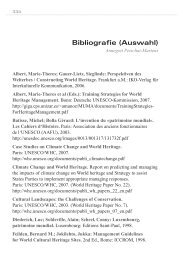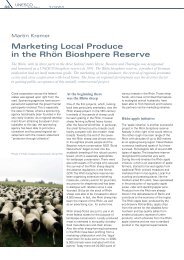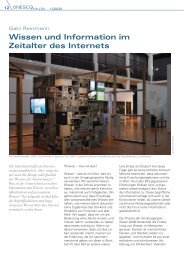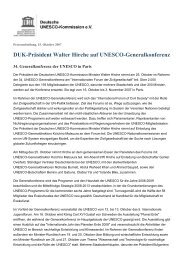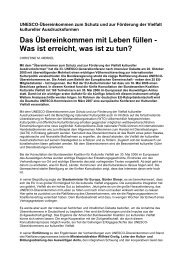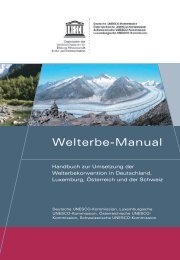Biosphere Reserves - UNESCO Deutschland
Biosphere Reserves - UNESCO Deutschland
Biosphere Reserves - UNESCO Deutschland
Create successful ePaper yourself
Turn your PDF publications into a flip-book with our unique Google optimized e-Paper software.
<strong>UNESCO</strong><br />
today 2|2007<br />
Education becomes<br />
a political instrument<br />
<strong>UNESCO</strong> <strong>Biosphere</strong> Reserve<br />
Upper Lausitz Heath and Pond Landscape<br />
This biosphere reserve, northeast of<br />
Dresden, represents the largest connected<br />
pond region in Germany. The rather<br />
small area is characterised by a vast<br />
diversity of ecosystems such as ponds,<br />
moors, heathland, pinewoods and flood<br />
plains. Animals and plants to be found<br />
here are otters, wolves, the white headed<br />
eagle, cranes, wild gladioli and water<br />
lilies. This region, spanning 301 km²,<br />
was designated by <strong>UNESCO</strong> in 1996.<br />
This region has been inhabited by the<br />
Sorbs since the 6th century, today a<br />
minded limitation of ‘education’ to the<br />
context of formal educational institutions,<br />
particularly of ‘school’. The focus will shift<br />
towards long-term changes in patterns<br />
of everyday behaviour (e.g. in consumption,<br />
production, mobility, building and<br />
living) and towards the underlying values,<br />
motives, future orientation, competences<br />
but also the social and physical-material<br />
contexts in which changes take place.<br />
Sustainable, but also non-sustainable<br />
behaviour patterns are not innate; they<br />
are learned and acquired from a very<br />
young age and are constantly reinforced<br />
culturally and socially. Up-bringing, education<br />
and learning are very important<br />
here, with as much attention having to<br />
be paid to relearning as to new learning.<br />
The term ‘learning for sustainability’ also<br />
makes it clear that new forms of learning,<br />
nationally recognised minority. These<br />
settlers have kept up their traditions and<br />
their Slavic language to this day. Carp<br />
have been kept in the ponds since the<br />
13th century and, inter alia, bred for the<br />
Saxon court. One of the aims of the<br />
biosphere reserve is to conserve this<br />
cultural landscape and the biodiversity<br />
created over the centuries by sustainable<br />
use, so that it remains intact for future<br />
generations. That is why the administration<br />
works closely with individual fishers<br />
and farmers. In parallel, it supports the<br />
Sorb culture; an example of this is the<br />
new learning sites and fields of action<br />
are required: Not only schools, nursery<br />
schools or other dedicated educational<br />
establishments are suitable as learning<br />
sites, but also many other spheres of life<br />
such as the home, the workplace, and<br />
the sports club. In biosphere reserves,<br />
information centres are not the only<br />
learning sites, but also the market<br />
place or the local crafts enterprise.<br />
A visit to a local council meeting, to the<br />
inter-generation café or simply preparing<br />
meals can all, directly or indirectly,<br />
contribute to learning processes and to<br />
gaining skills useful for shaping sustainable<br />
development. For these more<br />
general types of learning situations,<br />
new forms of learning, new learning<br />
media and also new partners must<br />
be sought for ‘teaching’ purposes.<br />
Photo © Ralf M . Schreyer<br />
extensive Sorb cultural programme<br />
regularly launched on the occasion of<br />
the spring and autumn nature markets.<br />
Environmental education plays a major<br />
role in the work of the biosphere reserve,<br />
not only, but primarily for children and<br />
teenagers. A wide range of activities are<br />
on offer such as excursions, seminars or<br />
holiday camps arranged with different<br />
target groups in mind. ‘Village children’ is,<br />
for example, aimed at teenagers living<br />
in the immediate neighbourhood of the<br />
biosphere reserve.<br />
Further information:<br />
http://www.biosphaerenreservat-oberlausitz.de<br />
Photo © Ralf M . Schreyer


